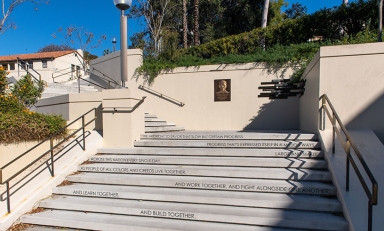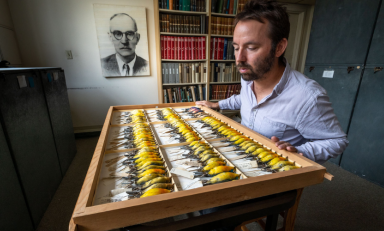Artist Libby Gerber '03 is building public art sculptures throughout Los Angeles where the urban and rural meet--from a Highland Park community garden to a canyon bridge nestled high in the San Gabriel Mountains. She erected her latest, "Monument to the Vista," in June at Fiji Hill on the Occidental College campus.
"I'm really interested in the idea of these places in Los Angeles where you forget that you're in a city," she said. "Los Angeles has a reputation of being dirty and smoggy, with gangs and tons of pavement. But I found the opposite. It's such a green city."
The piece at Occidental-a 6-foot tower of red and brown clay tiles of varying sizes--is part of an art installation project, LA: Observing the Urban-Rural, Gerber's master's thesis for an M.F.A. in public art and sculpture at Cal State Northridge. She graduated in June.
The sculptures are composed of reclaimed clay from Cal State Northridge's art department. The towers will remain where they were built until dismantled by man, animals, or nature. The series, Gerber said, could be seen as a meditation on the relationship between city and nature; on the effects of time and natural forces such as wind, rain, and heat from the sun; and on the influence that man has on his surroundings. Gerber checks on the sculptures' metamorphoses every few weeks.
"These installations are hopeful," she added, "but there is also a bit of sadness about them-they look old and precarious."
At Occidental, it took close to six hours on a hot summer morning for Gerber and a friend to haul 300 pounds of clay up a steep dirt trail and assemble the tower. On clear days, Fiji's 360-degree view affords vistas of Mt. Washington and Ernest E. Debs Regional Park to the south, the San Gabriel Mountains to the north and east, and a glimpse of the Pacific Ocean to the west. Unfortunately, Gerber's sculpture lasted less than a week before someone knocked it down.
Another sculpture, "Monument to the Triumphant River," built on the stone banks of the San Gabriel River, lasted a few weeks until it too was toppled. Gerber suspects that people pushed over the monument. Gerber's online photos document the sculpture's broken red clay tiles strewn on the river's banks. Only the clay sign stating the name of the monument remains intact.
The river monument was Gerber's most ambitious work, entailing 12 volunteers to haul hundreds of pounds of handmade tiles 10 miles roundtrip on rough terrain. The group assembled it within shouting distance of the "Bridge to Nowhere," an arched bridge built in 1936 for a road that was wiped out two years later by flooding.
"It's a natural human desire to interact with something," Gerber said. "I don't feel angry about it, but curious. I think most installations will meet their fate this way."
Gerber's monument series is ongoing. The first, "Monument to the Towers," was built in May at the Audubon Center at Debs Park. Another, "Monument to Seeds, Dirt, & Water" is located at the Milagro Allegro Community Garden in Highland Park. Native plants such as black sage, California bush sunflower, and sticky monkeyflower are also part of this tower.
A third, "Monument to the Lost Vegetables," is at South Central Farm, a deserted14-acre urban agricultural site at the corner of Martin Luther King Jr. Boulevard and South Alameda Street. Gerber hopes to build the last tower in an orange grove on the Northridge campus.



